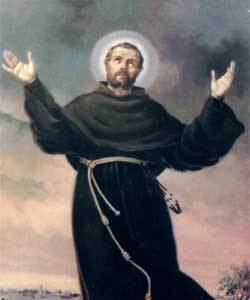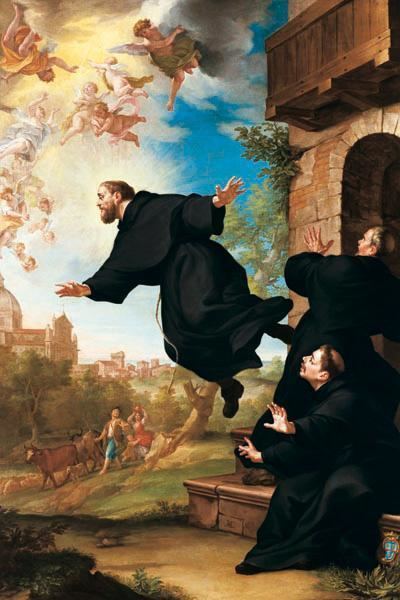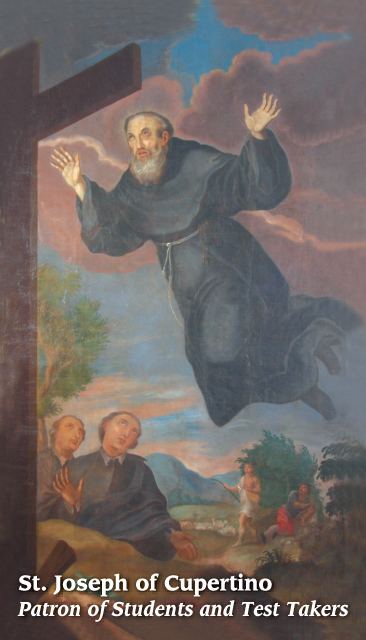Feast September 18 Name Joseph Cupertino | ||
 | ||
St joseph of cupertino the reluctant saint
Joseph of Cupertino, O.F.M. Conv. (Italian: Giuseppe da Copertino) (June 17, 1603 – September 18, 1663) was an Italian Conventual Franciscan friar who is honored as a Christian mystic and saint. He was said to have been remarkably unclever, but prone to miraculous levitation and intense ecstatic visions that left him gaping.
Contents
- St joseph of cupertino the reluctant saint
- St joseph of cupertino
- Life
- Skeptical reception
- Veneration
- References

St joseph of cupertino
Life

He was born Giuseppe Maria Desa, the son of Felice Desa and Francesca Panara in the village of Copertino|Cupertino, then in the Province of Apulia, in the Kingdom of Naples, now in the Italian Province of Lecce. His father having died before his birth, however, the family home was seized to settle the large debts he had left, and his mother was forced to give birth to him in a stable.

Joseph began to experience Religious ecstasy|ecstatic visions as a child, which were to continue throughout his life, and made him the object of scorn. His life was not helped by his frequent outbursts of anger. He was soon apprenticed by his uncle to a shoemaker. Feeling drawn to religious life, in 1620 he applied to the Conventual Franciscan friars, but was rejected by them due to his lack of education. He then applied to the Order of Friars Minor Capuchin|Capuchin friars in Martino, near Taranto, by whom he was accepted in 1620 as a lay brother, but was soon dismissed as his continued ecstasies made him unfit for the duties required of him.

After Joseph returned to the scorn of his family, he pleaded with the Conventual friars near Cupertino to be allowed to serve in their stables. After several years of working there, he had so impressed the friars with the devotion and simplicity of his life that he was admitted to their Order, destined to become a Catholic priest, in 1625. He was ordained a priest on March 28, 1628. He was then sent to the Madonna delle Grazie, Gravina in Puglia, where he spent the next 15 years.

After this point, the occasions of ecstasy in Joseph's life began to multiply. It was claimed that he began to levitate while participating at the Mass or joining the community for the Divine Office, thereby gaining a widespread reputation of holiness among the people of the region and beyond. He was deemed disruptive by his religious superiors and Church authorities, however, and eventually was confined to a small cell, forbidden from joining in any public gathering of the community.
As the phenomenon of flying or levitation was widely believed to be connected with witchcraft, Joseph was denounced to the Inquisition. At their command, he was transferred from one Franciscan friary in the region to another for observation, first to Assisi (1639–53), then briefly to Pietrarubbia and finally Fossombrone, where he lived with and under the supervision of the Capuchin friars (1653–57). He practiced a severe asceticism throughout his life, usually eating solid food only twice a week, and adding bitter powders to his meals. He passed 35 years of his life following this regimen.
Finally, on 9 July 1657, Joseph was allowed to return to a Conventual community, being sent to the one in Osimo, where he soon died.
Skeptical reception
Skeptics are not convinced that Saint Joseph possessed magical or paranormal powers. They have suggested that alleged eyewitness reports of his levitations are unreliable as they are subject to gross exaggeration, or written years after his death.
Robert D. Smith in his book Comparative Miracles (1965) suggested that Saint Joseph performed feats similar to a gymnast. Smith noted that some of his alleged levitations "originate from a leap, and not from a prone or simple standing or kneeling position, the witnesses mistook a leap of a very agile man for levitation."
Human poisoning due to the consumption of rye bread made from ergot-infected grain was common in Europe in the Middle Ages. It was known to cause convulsion symptoms and hallucinations. British academic John Cornwell has suggested that Saint Joseph had consumed rye bread (see ergot poisoning) . According to Cornwell "Here, perhaps, lay the key to his levitations. After sampling his own loaves he evidently believed he was taking off."
There exists an apocryphal story which says that Saint Joseph once levitated whilst in the presence of the Pope.
Nonetheless, it should be noted that Joseph's levitations were witnessed by scores of people, was thoroughly investigated by the church at the time, and subsequent to his death, underwent a vigorous examination by the Holy See as part of the beatification and canonization process. These found that the levitations were real, inexplicable, and due to supernatural causes.
Veneration
Joseph was beatified in 1753 and canonized in 1763. He has been declared the patron saint of air travelers, aviators, astronauts, people with a mental handicap, test takers and poor students.
